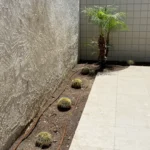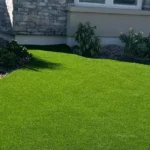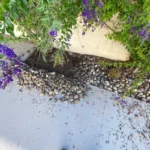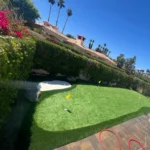Artificial turf is a fantastic, low-maintenance alternative to natural grass, but a little care can go a long way in keeping it looking lush and vibrant for years. Here’s everything you need to know about keeping your artificial turf in top shape, season after season.
1. Routine Cleaning: Keep Your Turf Looking Fresh
Regular cleaning keeps your turf free from dust, dirt, and debris, helping it stay green and inviting.
- Weekly Light Cleaning: Use a leaf blower, broom, or rake to remove leaves, twigs, and other debris that may accumulate on the surface. A stiff-bristled brush can help fluff up the blades and remove any settled dust.
- Monthly Deep Clean: For a more thorough clean, rinse the turf with a hose to wash away any lingering dirt. This is especially useful in dry or dusty climates.
- After Rainfall: Natural rainfall can act as a light cleaning, washing away dirt and dust, so you may find you need to clean less frequently after rain.
2. Pet Maintenance: Keep Your Turf Odor-Free
Artificial turf is a great choice for pet owners, but pet waste requires a little extra care to keep your lawn clean and odor-free.
- Solid Waste: Pick up solid waste as soon as possible. Rinse the spot with water to remove any residues and prevent odors.
- Liquid Waste: To prevent odors from urine, rinse the area thoroughly with a hose. For a deeper clean, you can use a pet-friendly enzyme cleaner designed for artificial turf.
- Odor Control: If odors persist, apply a turf deodorizer or pet odor neutralizer once a month to keep your lawn fresh and clean-smelling.
3. Stain Removal: Tackle Spills Quickly
Most spills won’t damage artificial turf, but cleaning them up promptly will keep it looking pristine.
- Food and Drink Spills: Blot any excess liquid with a paper towel, then rinse the area with water. For more stubborn stains (like coffee or wine), mix a solution of mild detergent with water, gently scrub with a soft cloth, then rinse thoroughly.
- Oil-Based Stains (like sunscreen or grease): For tougher stains, use mineral spirits sparingly on a cloth to lift the stain, and then rinse with water. Avoid using harsh chemicals, as they can damage the turf fibers.
- Chewing Gum: Harden the gum with ice, then scrape it off carefully with a plastic scraper. For any remaining residue, use a gentle, non-acetone adhesive remover.
4. Brushing and Fluffing: Restore the Turf’s Fullness
Over time, high-traffic areas of your turf may flatten. Brushing the turf will help maintain its lush, upright appearance.
- Monthly Brushing: Use a stiff-bristled, non-metal brush or broom to brush the turf fibers upright. Brush against the grain for best results, especially in areas that experience the most foot traffic.
- Redistributing Infill: If your turf has infill (sand or rubber granules), it may shift over time. Redistributing the infill periodically helps maintain the turf’s cushioned feel and upright fibers.
5. Weed Control: Prevent Weeds Around the Edges
Artificial turf is highly resistant to weeds, but occasional maintenance can keep your lawn edge neat and free from unwanted growth.
- Edge Maintenance: Weeds can sometimes grow around the edges of turf, especially if it borders soil or plants. Use a weed killer specifically designed for synthetic grass or manually pull weeds that appear.
- Prevention: If weeds become a frequent issue, consider applying a weed barrier or installing edging to prevent weeds from spreading onto your turf.
6. Seasonal Care Tips
While artificial turf is designed to withstand all kinds of weather, a few seasonal tips can help keep it looking its best.
- Summer: Keep an eye on any spots that may get hot from direct sunlight. If possible, rinse turf occasionally to help it stay cool. “Cool-Tech” turf products can help maintain comfortable temperatures.
- Fall: Clear leaves regularly to prevent mold or mildew from forming. Brushing will also help prevent fibers from flattening under wet, heavy leaves.
- Winter: Snow doesn’t damage artificial turf, but avoid using metal shovels or tools that could tear the surface. A plastic shovel is ideal for removing snow without harming the turf.
7. Protect Your Turf: Avoid Damage from Heavy Objects
Artificial turf is durable but can be damaged by sharp objects or heavy items.
- Furniture Pads: Place furniture pads under the legs of patio furniture, grills, or other heavy items to protect the turf.
- Avoid Open Flames: While artificial turf is flame-resistant, it’s best to keep fire pits, grills, or other heat sources off the turf to avoid accidental damage.
- Limit Car Traffic: If you need to drive over the turf (for example, with a lawn tractor), use caution to avoid compressing or tearing the turf fibers.
8. Annual Inspection: Extend the Life of Your Turf
Once a year, do a thorough inspection of your turf to identify any areas that may need extra attention.
- Check Seams and Edges: Look for any loose seams or edges and repair them if needed to prevent further wear.
- Assess Infill Levels: If your turf has infill, check whether it needs a refresh. Adding more infill as needed helps maintain softness and stability.
- Professional Maintenance (Optional): If your turf is several years old, consider hiring a professional turf cleaning or maintenance service. They can handle any repairs, deep cleaning, and infill redistribution to keep your lawn in prime condition.
Conclusion: Enjoy a Beautiful, Low-Maintenance Lawn
Maintaining artificial turf is straightforward, but following these simple steps will keep it looking beautiful and feeling great for years to come. Whether you’re a pet owner, a busy homeowner, or just want an effortlessly green lawn, a little care goes a long way in preserving the vibrancy and durability of your artificial turf.
Need help with your artificial turf?
